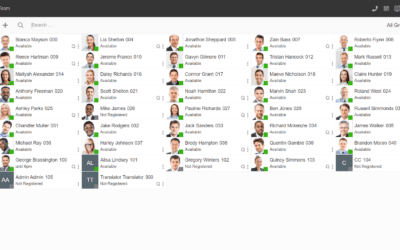We live in a digital era where your customers would prefer to tweet than talk on the telephone. You now need to effectively communicate not just with your customers, but with your workforce across multiple devices, formats and platforms. Embracing such digital diversification is a must-have for businesses to remain competitive. A recent report found the customer experience will overtake your products and pricing as the key brand differentiator by 2020.
Your customer comms strategy will play a massive part in this experience. Gartner predicts in 2019 more than half of organisations will increase spending on their customer experience innovations.
Further research reveals businesses with strong omni-channel customer engagement strategies retain an average of 89% of their customer base. However, those with weak omni-channel strategies only retain one-third of customers.
Within the world’s workforce, 42% of employees claim different communication styles are a leading cause of miscommunication at work. Nearly two-thirds of respondents also believe internal communications could be improved using a wider range of tools.
We are living in digitally dynamic and diverse times. Whatever format your customers or workforce demand, you have to expedite a streamlined service and speedy responses to every query.
This is where Unified Communications can help.
The main objective of Unified Communications is to unify and streamline any business procedure that involves human communications.
As such, Unified Communications consolidates several mobile and digital communication technologies into one framework. This effectively blurs the lines between your communication channels. For example, a user can choose to access a voicemail on their smartphone or using their email.
The resulting user experience should be seamless and work across any platform or device. By connecting people, applications, clouds and networks, Unified Communications has the power to transform how quickly and efficiently information is shared across the business. This is critical with customers waiting for answers to their queries or staff that need to quickly and efficiently collaborate.
In other words, Unified Communications speeds up your response times, boosts employee productivity and your customer loyalty.
What is Unified Communications?
Unified Communications brings together all the ways your business communicates. It lets these different channels “talk” to each other. This means they can work together in one system, boosting the efficiency of your business.
Unified Communications spans a wide range of communication channels. These include:
- Text tools, including email, messaging and chat
- Voice applications, including telephony, voicemail and audio conferencing
- Video services, such as video conferencing
- Web-conferencing platforms, integrating classroom tools such as interactive whiteboard and screens
- Real-time presence, where a user’s status is available across your organisation.
Some of these communication channels, such as email, are “asynchronous”, which means communication takes place at the user’s own convenience. In other words, information is delivered in one direction and remains accessible indefinitely.
Other communication channels, such as video conferencing, are “synchronous” and require real-time communication.
Unified Communications aims to integrate the software that supports both asynchronous and synchronous communication so the end user can easily access any tool to communicate with your business.
How does Unified Communications work?
A Unified Communications environment typically supports one or more back-end systems, typically referred to as the Unified Communications platform or server.
This platform facilitates the integration of your services and provides a front-end for your staff and customers to access them. This includes:
- Traditional, IP or cloud-based private branch exchange (PBX)
- Devices including phones, smartphones, headsets, microphones and cameras
For example, the 3CX system enables one-click collaboration using a WebRTC-based web client and integrated video conferencing. WebRTC is a powerful open source tool that enables real-time communication to be embedded into web browsers.
Using 3CX, you can access communication tools including video and audio conferencing, upload and present PowerPoint presentations and access with classroom features at the click of a button.
You could also see the presence of your colleagues (avoiding unnecessary call transfers or voice mail messages) and get faxes and voicemails delivered straight to your inbox.
In conclusion
Unified Communications brings together all of your communication platforms into one efficient system. It helps organisations of all sizes and across all industries to connect with customers and colleagues more efficiently, regardless of the method of contact.
If you’d like to find out more about Unified Communications and how it could help your business, contact one of our team today.






0 Comments